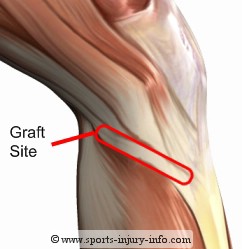Several people have asked me what exactly I had done on my knee. So instead of explaining the whole surgery to people, I thought I'd just explain the surgery here and link people to this post when they ask (with the aforementioned warning that it is a surgical procedure and that those who are squeamish should proceed with discretion).
First off, let's go over what makes up the knee, as far as ligaments go. The knee is stabilized by a pair of cruciate ligaments. The ACL (anterior cruciate ligament) is critically important because it prevents the tibia (the larger bone in your calf) from being pushed too far forward relative to the femur (your thigh bone). It is often torn during twisting or bending of the knee (in my case, a nasty 4-wheeler incident about 6 years ago).
The PCL (posterior cruciate ligament) is the second of the two. Injury to this ligament is uncommon but can occur as a direct result of forced trauma to the ligament. This ligament prevents your calf from slipping behind your thigh (ICK). (wikipedia)
In ACL reconstructive surgery what the surgeon does is replace a torn ACL with a tissue graft replacement (in my case, a graft of my hamstring was used - see below).
Without showing you gross surgery pictures, I'll show you a medical illustration of what ACL reconstructive surgery is (see below)
(don't worry... I was asleep for this whole thing lol)
And here are those sites on my knee. As you can see, Arthroscopic surgery is very non-invasive, leaves minimal scarring, and actually allows healing to move forward much quicker than the older, more invasive methods of knee surgery (which I'm continually thankful for).
In addition to the ACL reconstruction, I also had to undergo a Medial Meniscus Repair.
The menisci of the knee joint are two pads of cartilaginous tissue which serve to disperse friction in the knee joint between the lower leg (tibia) and the thigh (femur). They are shaped concave on the top and flat on the bottom, articulating with the tibia.
The menisci act to disperse the weight of the body and reduce friction during movement. Since the condyles of the femur and tibia meet at one point (which changes during flexion and extension), the menisci spread the load of the body's weight. (wikipedia)As you can see in the image to the left, the Medial Meniscus is the piece on the inside edge of the knee. It's likely I tore mine during the several years after the initial ACL tear, after each time my knee gave out (all you college friends can now appreciate why I swore so much when I landed on the other side of that fence... lol).
The repair isn't always possible if the tear is bad enough or if the tissue just isn't in the right position to repair it. Fortunately mine was able to be repaired. UNfortunately, because I had this repair done as well as the ACL reconstruction, my healing time is much longer, the swelling is worse, and it is why I can't bear weight on my knee quite yet and also why I have to remain in the splint and on the crutches for so long.
So that's the surgery I had on October 24th, for all those curious minds out there :)





No comments:
Post a Comment
Your feedback is always appreciated. Rude, solicitous, or spam comments will be deleted.